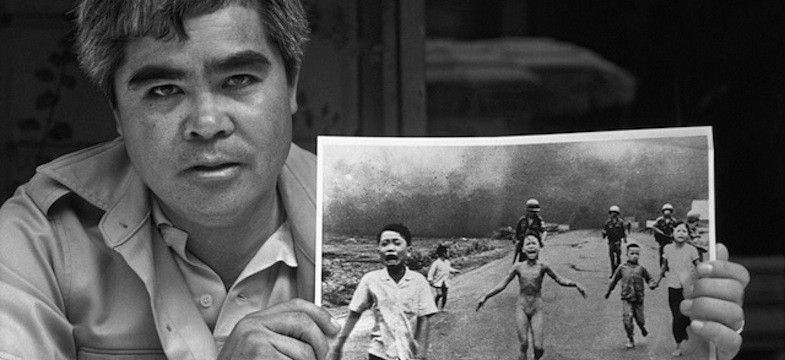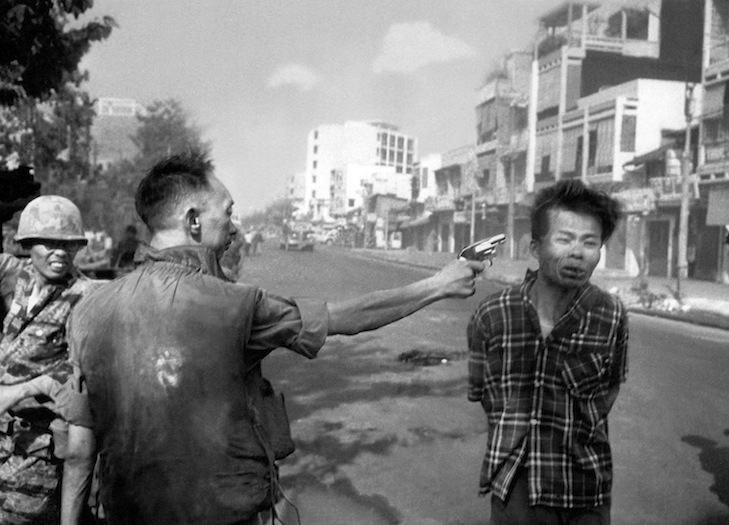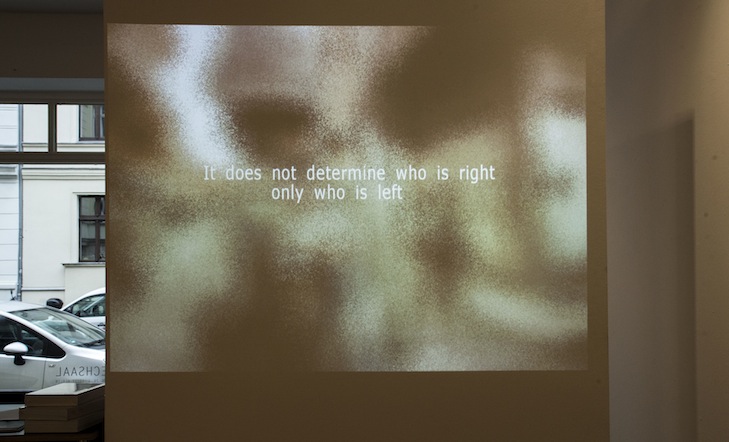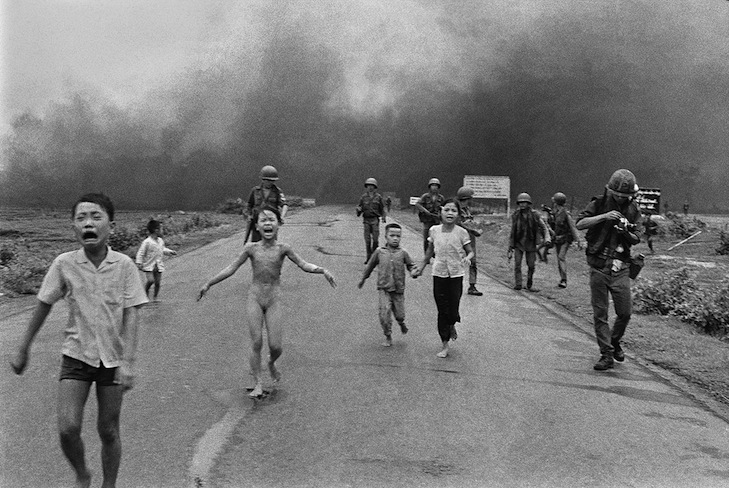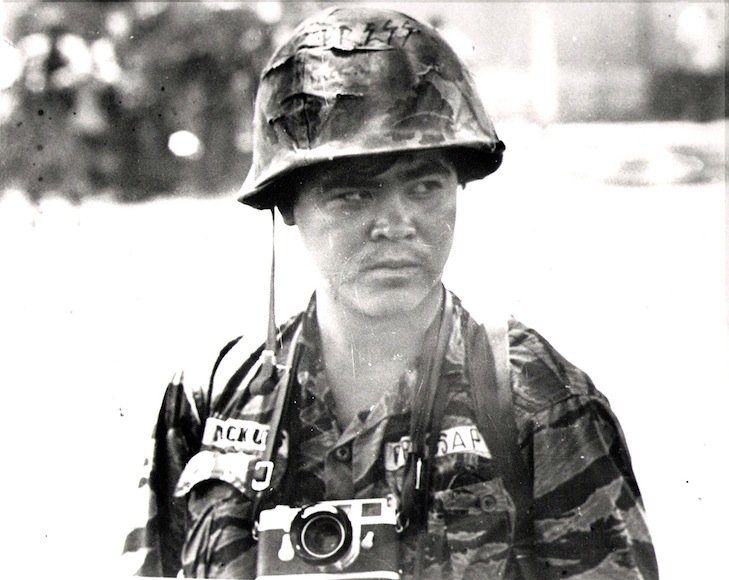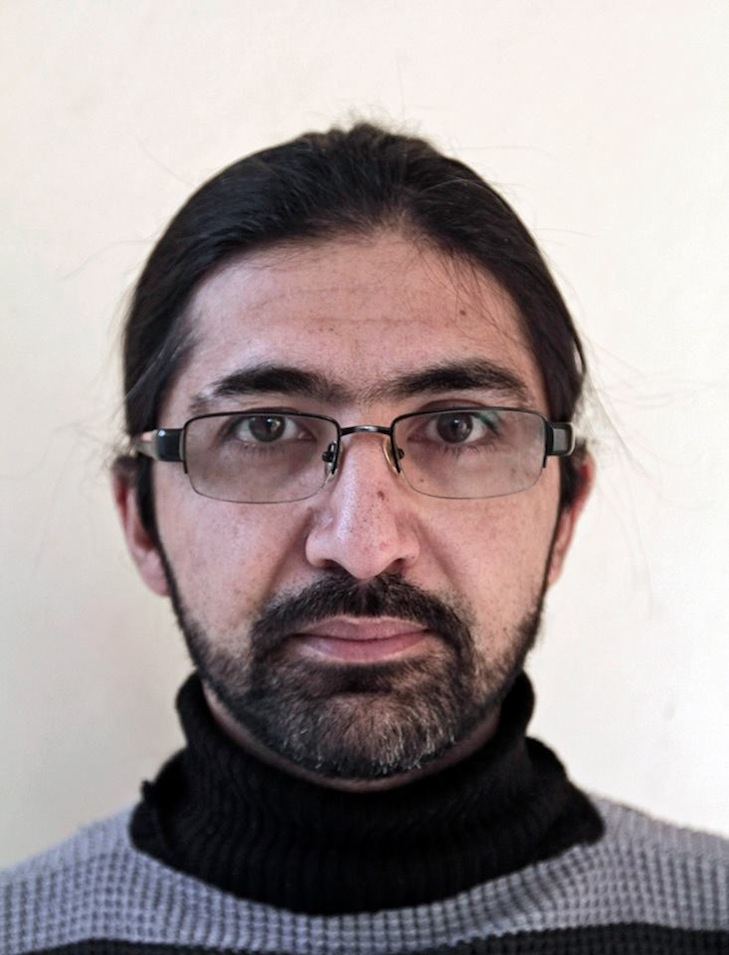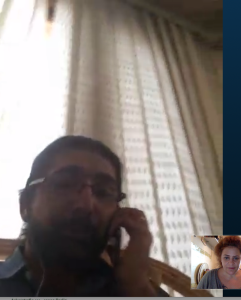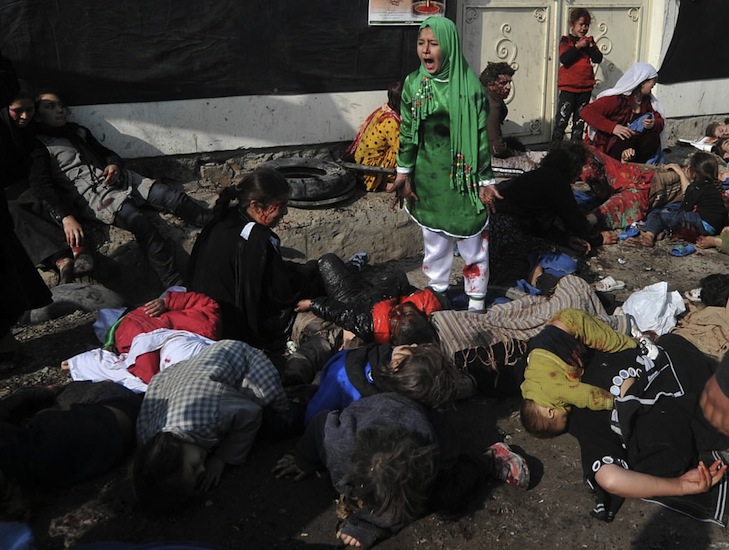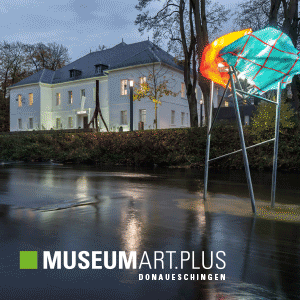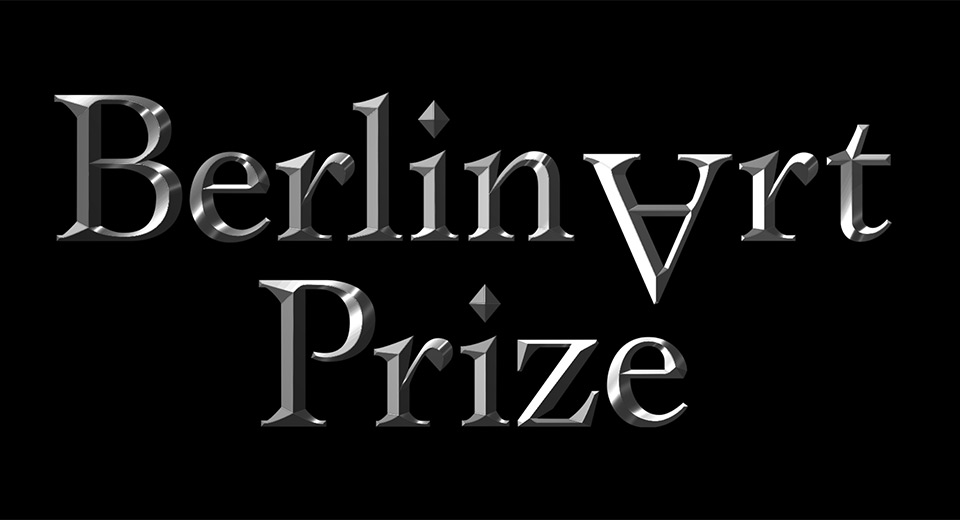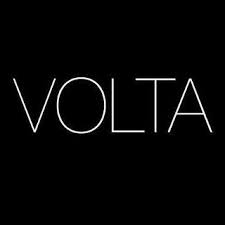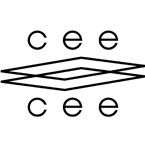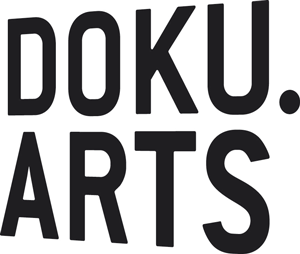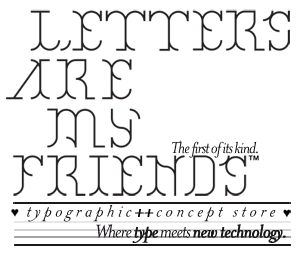Wie Kriegsfotografie uns und sich verändert hat
Am 24. Oktober 2015 (Laufzeit bis 11. Dezember 2015) eröffnete eine wichtige, schwere Ausstellung im Sprechsaal. MEDIATING WAR bringt 15 ikonische Kriegsfotografien nach Berlin, die alle mit dem renommierten Pulitzerpreis ausgezeichnet wurden. Die Ausstellung beschäftigt sich mit der Wahrnehmung und Entwicklung der Kriegsfotografie von den 60er Jahren bis zur heutigen Zeit. Darunter sind Werke von Kriegsfotografen wie Eddy Adams, Craig F. Walker, Carol Guzy und Mohammed Khalid.
Die meisten der Bilder kennen wir, sie haben sich in das kollektive Gedächtnis eingebrannt.
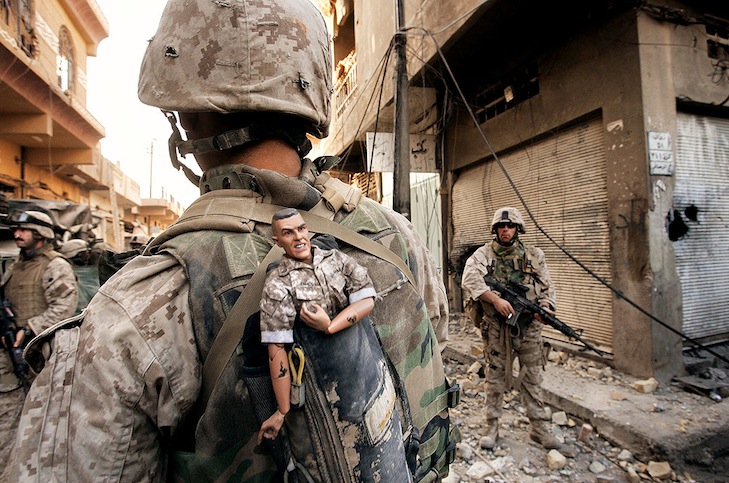
© AP (Associated Press), Anja Niedringhaus 2004
Auch die von der Fotografin Anja Niedringhaus in November 2004 festgehaltene Aufnahme, eines US-Marine-Soldaten der 1. Division, der einen Glücksbringer an seinem Rucksack befestigt hat, während er mit seiner Einheit in den westlichen Teil von Fallujah vorrückt, ist dabei. Anja Niedringhaus wurde mit nur 48 Jahren im letzten Jahr in Afghanistan während der Präsidentschaftswahlen erschossen, als sich ein mutmaßlicher Polizist ihrem Wagen näherte und mit den Worten „Allahu Akbar“ („Gott ist größer“) das Feuer eröffnete. Ihre kanadische Kollegin, die Journalistin Cathy Gannon, überlebte schwer verletzt. Anja Niedringhaus war die erste deutsche Fotografin die 2005 den Pulitzerpreis verliehen bekam.
Der Kuratorin von MEDIATING WAR, der Fotografin Semra Sevin, ist es gelungen die in ihrer Brutalität und Direktheit schwer zu ertragenden Bilder mit drei interaktiven, zwei davon digital, in ihrer Funktionalität und Wirkung wirklich fantastischen Installationen, aufzubrechen. Damit eröffnen Semra Sevin, Peter Kirn und Peter Kolski dem Ausstellungskonzept einen zusätzlichen Raum und dem Besucher eine ganz persönliche Wahrnehmung von Krieg.
Wir haben uns anlässlich der Ausstellungseröffnung mit dem ältesten, und wohl mit Abstand bekanntesten noch lebenden Fotografen, Nick Ut sowie mit dem jüngsten seiner Zunft, Massoud Hossaini, getroffen.
Nick Ut ist absolut präsent.
Seine Augen überall im Raum, zeigt er uns auf seinem Laptop eine Diashow von seinen Arbeiten, die uns sein Leben erzählen. Vom Vietnamkrieg und unzähligen Kriegsbildern zu Celebrity Schnappschüssen, wie die weinende Paris Hilton auf dem Weg ins Gefängnis, oder Michael Jackson auf dem Weg zu seiner Verhandlung. Nick Ut lebt und arbeitet in Los Angeles und fotografiert immer noch was ihm vor die Linse kommt, das sind in L.A. natürlich vor allem Hollywoodstars. Dennoch lässt ihn der Krieg bis heute nicht los.
Das hier folgende Foto von Nick Ut hat maßgeblich die weltweite Wahrnehmung des Vietnam Kriegs verändert und dazu beigetragen, dass der Krieg früher beendet werden konnte. Nick Ut war damals 21 Jahre alt und arbeitete als Kriegsfotograf für AP (Associated Press).
Mit Kim Phuk, dem sogenannten „Napalm Bomb Girl“ ist er bis heute im engen Kontakt. Dank seinem Einsatz hat die heute 53-Jährige damals überlebt. Er schüttete sofort eine Flasche Wasser über sie, wickelte sie in einen Militär-Umhang und brachte sie in das nächste Krankenhaus.
File Photo: Nick Ut with Phan Thi Kim Phuc Girl in Iconic Vietnam War photo Bring Message of hope, picture took this year in May, 2009 at Vietnam VeMemorial Soldiers in Washington D.C ,(AP Photo/Nick Ut (AP Photo/Nick Ut)
Nick, you took your famous photo of Kim Phuc at a very young age. Your brother was a photographer and got killed in the Vietnam War. Is that how you became a war photographer?
Yes. When my brother was killed while working as a photographer, I decided I wanted to be like him. I went to the AP office and asked for a job.
They told me to go home because I was too young. I said to them that the AP office was my home now. The editor decided to give me a job as a runner. Soon after, I became a photographer as well.
You were wounded several times in war yourself. How could you overcome your fear and go out facing war again and again?
I was wounded three times while serving as a photojournalist for AP. I knew I had to keep my brother’s memory alive and it did not matter to me that I was shot or that I might die. I wanted to tell the stories that my brother could not tell anymore. I continued to work even after being shot because my brother would have liked me to continue. My brother would never quit so I didn’t.. My job was to tell my country’s story through my photography.
There are sources that say a 3rd world war is around the corner. What is your opinion?
I do not think a 3rd World War is possible today.
We have many resources available that stop or even alleviate regional conflicts. The United Nations negotiates up to a point. Alliances of countries can bring resolution to many conflicts before they get out of hand. Many smaller wars do still happen but a major war that involves many countries, in my opinion, I don’t think is possible anymore. Whenever there has been conflicts, countries come together and figure out a way to stop them before they get out of hand and involve many multiple countries.
Massoud Hossaini – einer der mutigsten jungen Kriegs-Fotografen
Hossaini gewann 2012 als erster Afghane den renommierten Pulitzerpreis für sein Foto, das ein schreiendes, zwischen Körperteilen stehendes Mädchen nach einem Selbstmordanschlag auf ein schiitisches Heiligtum zeigt. Das war in Kabul im Dezember 2011. Massoud stand damals nur einige Meter entfernt. Und genau hier lebt und arbeitet er bis zum heutigen Tag für die Agence France-Presse. Sein Alltag ist bis heute der Krieg. Unser Interview haben wir per Skype geführt.
Massoud Hossaini wird in Kabul während des Soviet Krieges geboren. Als er sechs Monate alt ist, wird sein Vater, ein Gegner des kommunistischen Regimes, verhaftet. Die Familie flüchtete in den Iran, wo Hossaini aufwächst. Nach seinem Schulabschluß wird Hossaini selbst politisch und schließt sich der Iranischen Reform Bewegung an. Ab diesem Zeitpunkt beginnt er die Geschehnisse mit seiner Kamera zu dokumentieren, vor allem die afghanischen Flüchtlinge in Mashhad. Nach 9/11 geht er zurück nach Afghanistan, schließt sich der französische Kulturorganisation Aina an und beginnt bei Manoocher Deghati Fotografie zu studieren. Seit 2007 arbeitet er für AFP (agence france press).
Ich erreiche den 33- jährigen Massoud auf seiner Arbeit, dem Büro der Agence France-Presse. Er schwenkt kurz zu einem Kollegen der in die Kamera winkt, ansonsten ein schlichter Raum in Brauntönen, Vorhänge vor den Fenstern, es sieht irgendwie aus wie aus eine Szene aus Homeland.
Massoud when you were six months old your family had to flee from Afghanistan to Iran as your father was arrested by the communist regime. A situation thousands of people are facing today again. How did it form you as a person?
Growing up in iran in a different society which has it´s own problems and to live and to grow up with Iranians made me feel completely disconnected with Afghanistan.
I was melted into the Iranian culture. I wasn´t even informed back then, what was going on in my country. All this gave me the feeling that I am from a country that will never have peace. But after 11th of September there was a chance.
You started as a political activist after finishing Highschool, why did you move to photography, what is your motivation?
After Highschool, the Afghanistan society I found back then in Iran was leading a very sad life. Most of them were illegal refugees. I found out that they came from the place half an hour away where I was born, but the people in Afghanistan didn’t know about the bad situation of the refugees in Iran. I got really upset, I was shocked. They didn´t have water, electricity, nothing. That was a big shock for me, because I grew up in Iran, I was living with Iranians and I didn’t know that the government wasn’t aware of this situation. So I wrote some letters to some newspapers and to the new Iranian reform movement, and they wanted more details about it. That was the reason why I started photography. To try to take pictures to prove that is 100% reality.
When I came to Afghanistan after September 11th, I wanted to show everything about life there, not only the war, and the poverty but also the beauty of the nature, the beauty of the faces of the girls, the daily life. At that time the war against terrorism had already started so I joined AFP (agence france press).
An dieser Stelle klingelt sein Handy, es gibt einen „Zwischenfall“, Massoud muss sich sofort mit seinem Office in Verbindung setzen. Er lässt sich entschuldigen und verspricht so schnell wie möglich zurückzurufen. Schlagartig wird mir klar wie alien diese ganze Situation ist. Ich sitze hier in meiner Küche bei einer Tasse Tee und skype mit einem Kriegsfotografen der sich in einer Kriegszone befindet. Ein Platz der vom Terrorismus beherrscht wird. Um ihn herum ist Krieg. Die ganze Zeit. Das ist seine Realität. Ich bekomme mit einer bitteren Klarheit eine neue Relation auf mein Leben in Deutschland. Eine Viertelstunde später ruft er zurück und wir können unser Gespräch weiterführen.
If you think about a place of protection what comes to your mind?
For sure I want to live in a safe country like Canada, European countries or England and protect my family from all these brutal action which is going on here.
But in the end all these stories are coming into my mind. Even when I am at a party or out of this hell. Then I cry which makes other moments sad too.
But still you go on?
Yes I go on and it is important, as we have a weak government with no idea to solve the problems.
But how can you endure it?
It is very difficult. I try to be strong because I feel this is my responsibility to tell the story of my country which is under a brutal war. Even right now that I am talking to you, we are working on a girl’s story who was stoned after she run away with a man she fell in love with and wanted to marry.
Do you think there will be any chance on normal structures or a free Afghanistan again?
We will have a free Afghanistan if the worlds power honestly helps us to develop our country which they wont.
I don’t know what to say. I pray for you wellbeing. thank you for your time Massoud.
You are welcome.
Ausstellung MEDIATING WAR
Die Ausstellung MEDIATING WAR wurde bis zum 11. Dezember 2015 verlängert.
Adresse: Sprechsaal // Marienstrasse 26, 10117 Berlin
Öffnungszeiten: Mittwoch bis Samstag 14:00 bis 22:00 Uhr

